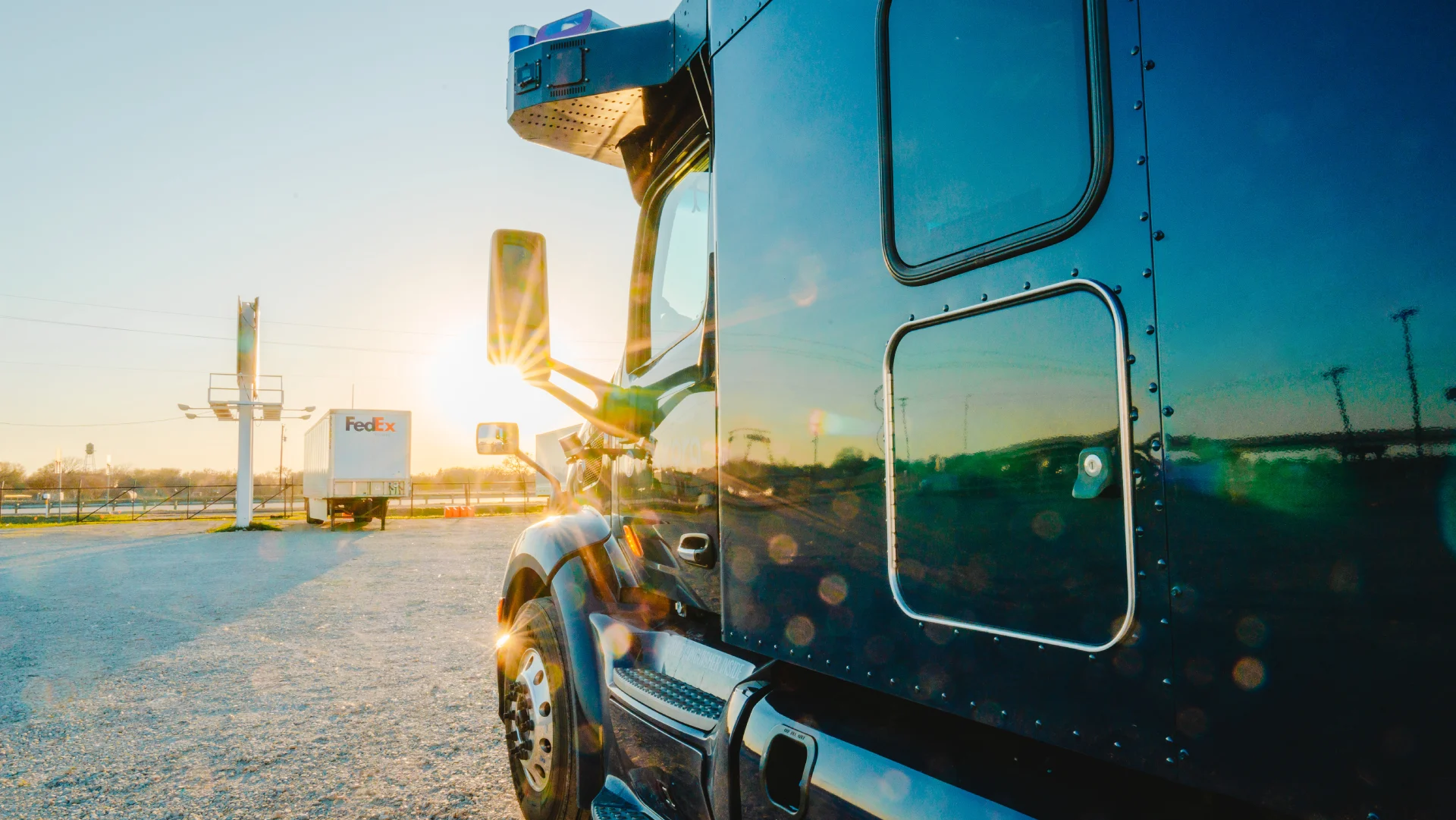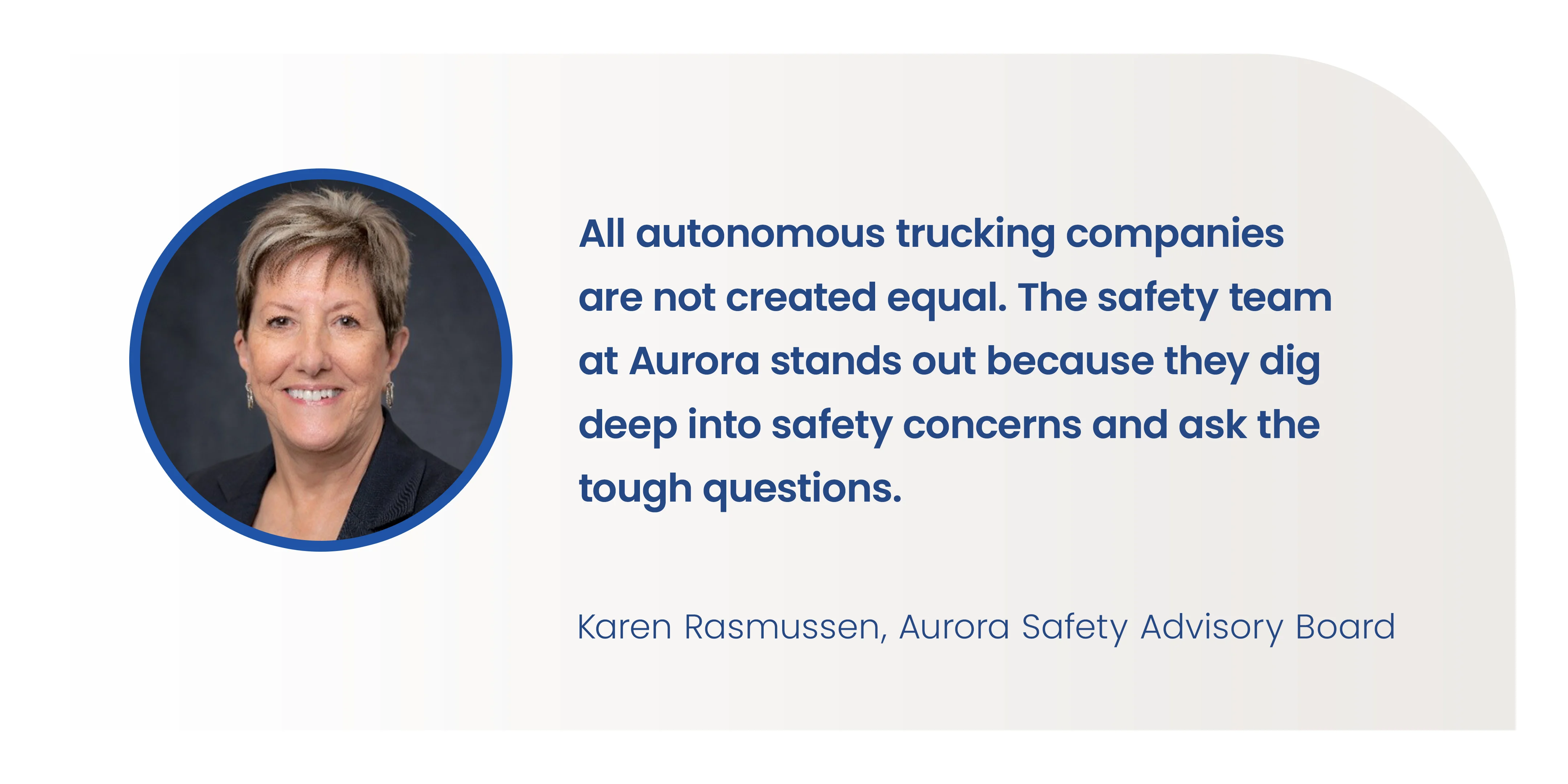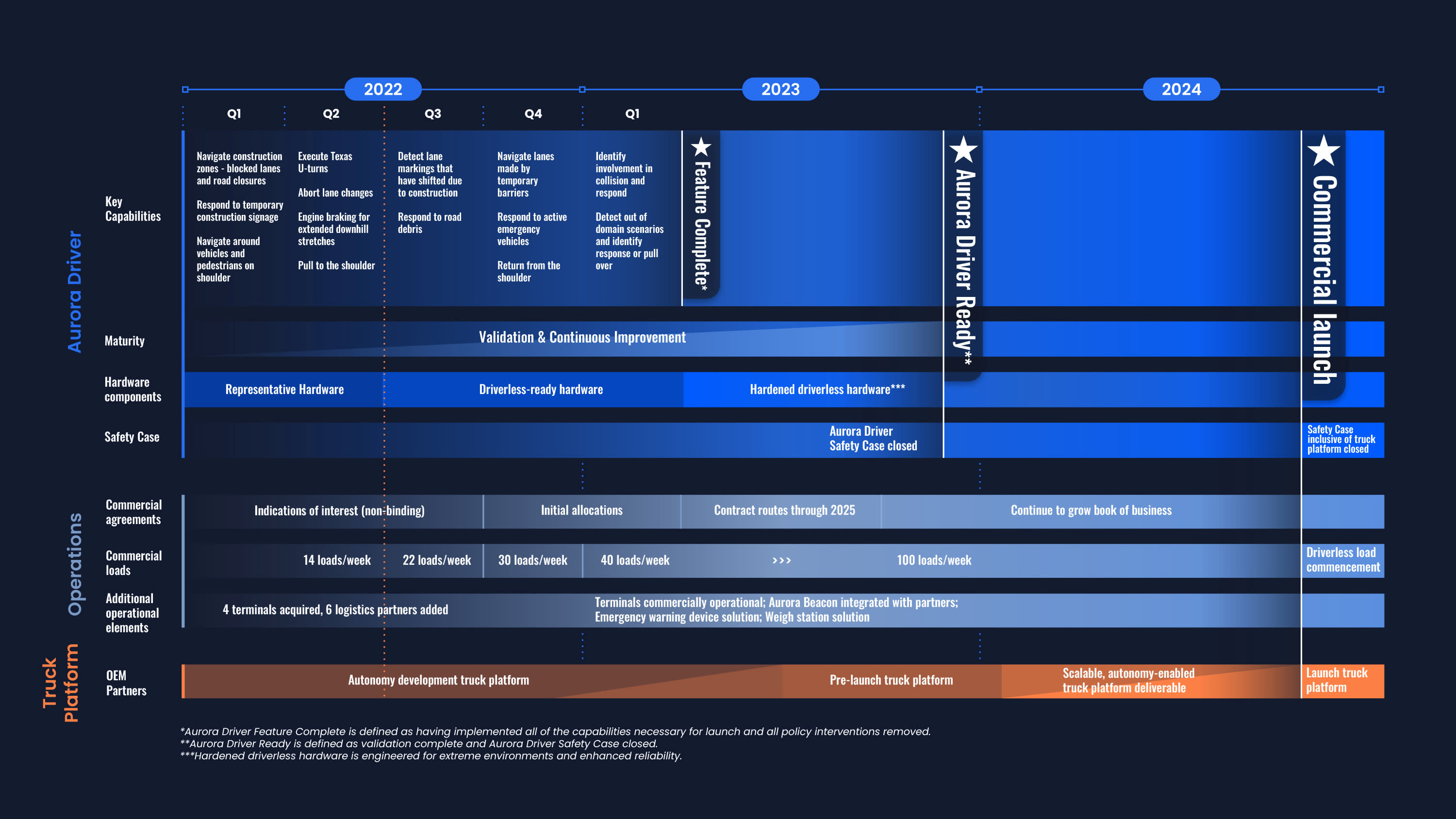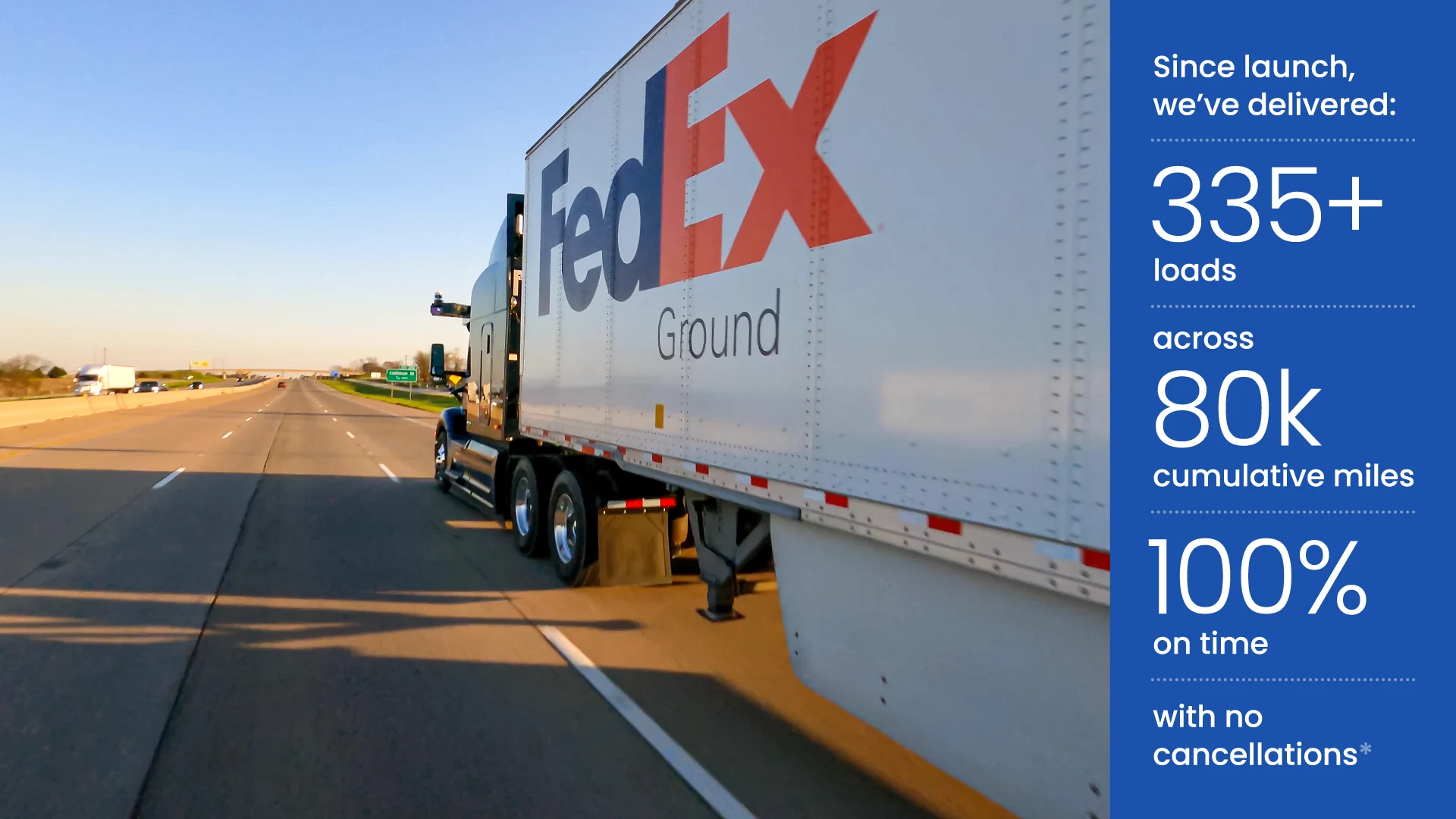Aurora’s Q2 2022 progress toward commercial launch
Recap | August 05, 2022 | 4 min. read

In our Q2 2022 Business Review call this week, we unveiled a first look at our Aurora Horizon Product Roadmap and shared exciting progress updates on everything from safety to new autonomy capabilities and customer pilots.
Here’s a recap of some of our most exciting moments from Q2:
Safety first
Safety concern reports: 100% of Q2 concerns closed
There’s a reason safety comes first in our mission—it’s at the core of everything we do. We prioritize developing and implementing safety best practices to ensure our employees are empowered and have multiple outlets to raise safety concerns without fear of retaliation. Through our Safety Concern Reporting system, we review and address this feedback to continuously improve our technology, policies, and internal practices. During the second quarter, we reviewed and closed 100% of safety concerns raised within the quarter.
Self driving and SMS: How we are implementing our Safety Management System

Fault management: Laying the groundwork for commercial operations
Our Fault Management System (FMS) is designed to actively monitor the health of our autonomous vehicles, including the self-driving software, sensors, and on-board computer. When it detects an issue, the FMS will intervene, navigating the vehicle to a safe stopping location where the issue can be addressed. This is a foundational capability for removing our vehicle operators and delivering a safe, commercial-ready driver.
In Q2, we demonstrated our FMS responding to artificial faults on Aurora Driver-powered trucks operating at highway speeds on public roads, taking a meaningful step toward satisfying the Fail-Safe core claim of our Safety Case. This accomplishment is the result of an incredible amount of work—our team defined, implemented, and validated over 1,000 FMS requirements while also making rapid advances across a range of other technological areas critical for commercial deployment.
Newly capable and on the path to feature-complete
We unveiled our roadmap for the commercial launch of our autonomous trucking product, Aurora Horizon, to outline the progress we have made so far this year and the work that remains between now and our planned commercial launch.

Beta 3.0
In Q2, we released Aurora Driver Beta 3.0. This update debuted capabilities to enable end-to-end autonomous operations between our terminals and allow the Aurora Driver to safely navigate increasingly complex and critical situations that are necessary for the deployment of our commercial trucking product.
With these advancements, we expect the Aurora Driver to be “feature-complete” by the end of the first quarter of 2023—meaning we will have implemented all of the capabilities necessary for launch and will have removed all policy interventions. (A policy intervention is when our operators preemptively disengage the Aurora Driver when we know it is not yet capable of confidently navigating a particular scenario.)
A runaway truck? Not on our watch.
In this video, the Aurora Driver is traveling on the major freight route between Fort Worth and El Paso, descending Ranger Hill on I-20 for three miles at a 3.5% downgrade. Without engine braking, this hill cooks a truck’s brake pads, reducing their life dramatically. In Q2, the Aurora Driver learned to autonomously apply engine brakes while driving downhill, increasing safety for all drivers on the road.
Turns you can only find in Texas
In this video, the Aurora Driver has just exited our El Paso terminal and is making an unprotected right turn onto a westbound frontage road. It then proceeds to execute a Texas U-turn to merge onto I-10 eastbound toward Fort Worth. To confidently navigate Texas freight routes, the Aurora Driver must be able to handle these kinds of complicated road features.
To change lanes or not to change lanes?
The National Highway Traffic Safety Administration’s data shows that 9% of all accidents occur during lane changing and merging on highways. Given this relative frequency, we've continued to refine the logic by which the Aurora Driver reasons about and negotiates lane changes with other actors.
In this video, the Aurora Driver is planning to change lanes but another vehicle aggressively cuts in. The Aurora Driver recognizes that another vehicle is now occupying that space and safely returns to its lane, later executing the lane change once it is safe to do so.
No landmarks? No problem.
Over the course of Q2, we drove a significant improvement in required vehicle operator interventions due to localization issues on our Fort Worth to El Paso lane, with no interventions in the final weeks of June. This improvement stems from advancements in the Aurora Atlas (our HD mapping system) and the Aurora Driver that enable our vehicles to better adapt between using lane markings and geometric data to precisely position themselves. 
These developments make the Aurora Driver’s performance more robust in construction zones and highway segments with few distinct road features or long stretches of rapidly growing vegetation—all conditions that are common on rural routes like Fort Worth to El Paso.
More loads + More roads = More value for Aurora Horizon customers
335 loads, 2x commercial miles, and counting
During Q2, we doubled our commercial miles driven across our pilots and lanes and also saw improved autonomy performance when compared to the first quarter.
Our pilot with FedEx has allowed us to refine our operations and prepare for future growth. We’ve been autonomously hauling FedEx loads daily between our Dallas and Houston terminals, and weekly between our two new terminals in Fort Worth and El Paso. Throughout Q2, we delivered over 335 loads by driving over 80,000 cumulative miles, with 100% on-time performance and with no cancellations. With each trip, the Aurora Driver has transported packages for thousands of FedEx customers. 
From Dallas to San Diego
As we work closely with our pilot customers and partners toward delivering our product, we also continue to engage with policymakers on their support for the safe development and deployment of self-driving technology.
In Q2, we continued to build legislative and regulatory support in California and Pennsylvania. We worked with others in our industry to encourage regulation to permit deployment of autonomous trucks in California and advance legislation in Pennsylvania that would facilitate fully autonomous operation in the state.
We were also recently informed that the state of Arizona has granted our request to test and operate in their state, and we have submitted notification of our intent to operate in New Mexico. From a regulatory perspective, this means we will be able to commercially deploy our self-driving technology in Texas, New Mexico, and Arizona when we are ready to do so, bringing us one step closer to deploying on one of the busiest freight corridors in the country, from Dallas to San Diego.
On the roadmap for commercial launch
For the rest of 2022 and into the first quarter of 2023, our technical development work will focus on releasing the remaining capabilities that we expect the Aurora Driver will require to transport commercial loads on our first commercial routes. During the third quarter of 2022, we plan to launch capabilities that include identifying and responding to debris and navigating even more complex construction zones. Throughout development, we expect to continue validating the Aurora Driver’s capabilities and compiling the evidence for the safety case for our commercial launch.
We can’t wait to continue to show the world what the Aurora Driver can do as we make progress toward the commercial launch of our autonomous trucking product, Aurora Horizon, and advance our mission to deliver the benefits of self-driving technology safely, quickly, and broadly.
Delivering the benefits of self-driving technology safely, quickly, and broadly.